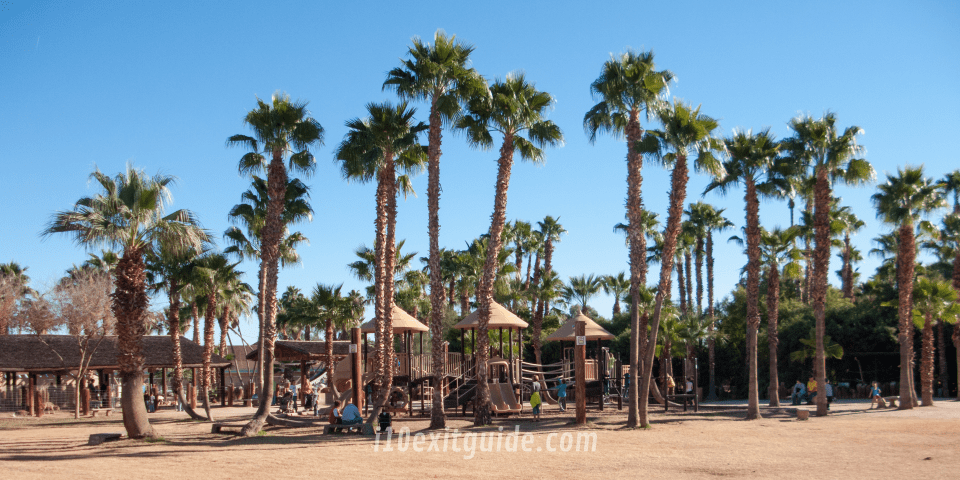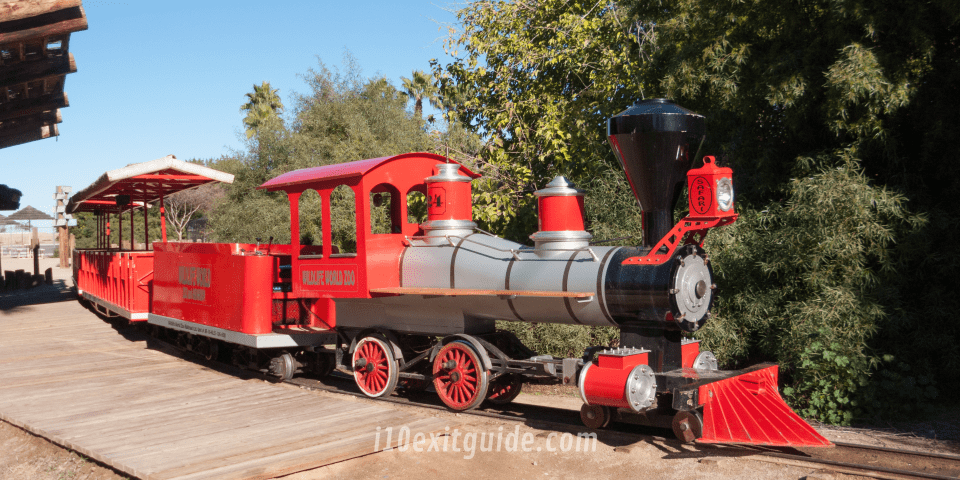If you’re cruising along I-10 through the West Valley and want a one-stop, family-friendly place to stretch your legs, cool off, and see an incredible variety of animals, Wildlife World Zoo, Aquarium & Safari Park in Litchfield Park is a standout. It combines a traditional outdoor zoo, an indoor aquarium complex, and a safari-style expansion with rides and up-close encounters, all on one sprawling property. For many visitors it ends up being a full-day experience—especially if you want to take in shows, rides, and the aquarium after the hottest part of the day. Here’s a thorough guide to help you make the most of your visit.
Wildlife World is a privately run zoological park located at 16501 W. Northern Avenue, Litchfield Park, Arizona, on the far west side of the Phoenix metro area. It’s known for having Arizona’s largest collection of exotic and endangered species—well over 600 species and many thousands of individual animals. The park has grown over decades from a small collection into a full-scale zoo, added a multi-building aquarium in the late 2000s, and later opened a safari park expansion with larger habitats and an aerial ride. The result is a big, diverse campus with a lot to see even if you’ve been to other zoos.
Park Details
The Zoo…
Wildlife World’s outdoor areas are broad and varied, with paths winding around lakes, desert landscaping, and clusters of habitats. Expect to encounter:
- Big cats and carnivores: Lions are a perennial favorite, and you may also see tigers and other felids in shaded enclosures. Depending on the season and the animals’ schedules you might catch them active in the cooler hours. Carnivore sections often include hyenas or wild dogs in the safari park expansion.
- African and Asian hoofstock: The park is strong on antelope and hoofstock species you don’t see everywhere—types of oryx, addra gazelle, kudu, and more. Zebras, giraffes, and other African grazers tend to be visible throughout the day.
- Primates: Lemurs, marmosets, tamarins, spider monkeys, and other primates live in island habitats and arboreal enclosures. You’ll hear the vocal ones before you see them on some mornings.
- Birds: Walk-through aviaries and free-roaming peafowl bring splashes of color to the pathways. There’s often a lorikeet feeding area where you can purchase nectar and hold out your cup as birds alight on your arm.
- Reptiles and smaller mammals: Don’t skip the smaller houses; Wildlife World has a tradition of showcasing unusual reptiles and small mammals you might miss at larger urban zoos.
- Giraffe feeding: A raised platform allows you to hand-feed giraffes. It’s one of the most popular experiences, best done early or late in the day when they’re hungriest. Buy a lettuce or cracker portion at the stand.

The Safari Park…
The “safari park” area spreads out with larger, open habitats designed for longer viewing lines and more expansive exhibits. Expect hoofstock herds, cheetahs, and other African species here, often with better sightlines than in tighter enclosures. The area is linked by paths and ride options, and it’s a good place to use the skyride or train for a bird’s-eye or ground-level circuit when you’re ready to give your feet a break.
A note on “safari park” terminology: Wildlife World’s safari park is a walk-through expansion, not a self-drive-through. You’ll view habitats from pathways, trains, and rides.
The Aquarium…
Wildlife World’s aquarium complex sits near the front of the property and is divided into multiple themed buildings. Inside, it’s comfortably air-conditioned and an excellent refuge in the midday heat. Exhibits change and update, but you can expect:
- Marine and freshwater galleries: Tanks showcasing rays, reef fish, and sharks, along with piranhas, arapaima, and other freshwater giants. Lighting is low and serene—great for photos and a cool-down.
- Touch tanks: Stingray touch pools are a kid magnet. For an extra fee, you can purchase cups of food to hold between your fingers while rays swoop up for a gentle snack. Staff typically brief you on safe feeding technique at the edge of the tank.
- Thematic sections: The aquarium buildings highlight tropical, river, and predator habitats, with interpretive signs about adaptations, conservation, and behavior.
- Sea lion presentations: Wildlife World is known for sea lion shows that blend education and playful behaviors. Showtimes vary; grab the day’s schedule as you arrive.
Shows, Attractions and Hands-On Moments
Program times at Wildlife World vary by season and staffing, but the park typically offers:
- Sea lion shows at a dedicated theater.
- Lory and parrot feedings where you can buy nectar and be part of the flock.
- Giraffe feeding windows at the platform.
- Stingray feeding in the aquarium.
- Wildlife encounters or keeper talks—short, educational presentations with small animals.
If you want to catch multiple shows, check the board near the Wildlife World entrance for that day’s schedule and plan your walking route around those time anchors. Keeper talks can be low-key highlights: smaller crowds and the chance to ask detailed questions.
Animals You Might Meet
Species lists evolve, but Wildlife World has historically showcased an unusually broad range. Expect many of these:
- Mammals: Giraffe, zebra, cheetah, lion, tiger, various lemurs, tamarins, marmosets, wallabies/kangaroos, antelope and gazelle species, and sometimes rarities like white rhinos.
- Birds: Lorikeets, macaws, cranes, storks, waterfowl, flamingos, and free-roaming peafowl.
- Reptiles and amphibians: Snakes, lizards, turtles and tortoises, sometimes crocodilians.
- Fish and aquatic life: Sharks, rays, reef fish, piranhas, arapaima, and other freshwater giants.
Some areas highlight specific geographic themes—Australia, Africa, tropical forests—while others mix species to emphasize adaptations and behaviors. That variety is part of the charm; you’ll often round a corner to find something unexpected.
Rides and Vantage Points
While animals are the main attraction, rides make Wildlife World stand apart from more traditional zoos:
- Skyride/aerial tram: Glide over habitats for panoramic views and a breeze. It’s a relaxing way to orient yourself and see where you want to go next. Not ideal for those with a strong fear of heights, but the ride is gentle.
- Safari train: A ground-level loop through sections of the park. Good for tired legs and for kids who love trains. Look out for antelope herds and waterfowl along the way.
- Boat ride: Often themed around Australian species, this ride can offer a close pass by pelicans, wallabies, and water-loving birds. Operating schedules can be seasonal.
- Kid rides: Carousels or small family rides may operate in peak periods. Rides usually require tickets or a wristband; check availability day-of.

Family and Kid-Friendly Features
- Hands-on encounters: Stingray touches, giraffe feeding, and lorikeet nectar cups engage even very young children.
- Ride breaks: If attention spans are flagging, the train or skyride doubles as a rest.
- Nearby rest stops: Benches and shaded gazebos are common. Use the aquarium buildings as climate control hubs for diaper changes and cool-downs.
- Pace: Wildlife World is large; if you’re traveling with toddlers, plan for a slower cadence and pick three must-do items rather than trying to see everything.
Dining and Snacks
You won’t go hungry at Wildlife World. Expect fast-casual stands for burgers, pizza, and kid-friendly options; grab-and-go kiosks for ice cream and drinks; and a sit-down restaurant associated with a local BBQ chain inside the aquarium complex. The latter offers the novelty of dining next to large tanks with fish and sharks cruising past. If it’s blazing hot outside, plan lunch here to recharge in the cold AC. Lines at peak lunch hours can get long, so consider a slightly early or late meal. Some guests bring their own snacks and water; policies on outside food may change, so confirm current rules before packing a picnic.
Visitor Tips and Suggestions
Time Budgeting
How long you spend at Wildlife World depends on your pace and interests:
- Quick sampler (2–3 hours): Head straight to the aquarium buildings for a cool-down, then prioritize a couple of outdoor highlights like giraffe feeding and a big cat habitat. If the train is running with a short wait, do a loop to cover more ground efficiently.
- Half-day (4–5 hours): Do an aquarium building or two, then a focused walking loop through the zoo side, plus one ride. Catch a show if the timing works.
- Full day (6–8 hours): Start at open with the giraffe feeding and active carnivores, switch to the aquarium by late morning, grab lunch inside, then spend the afternoon in the safari park section with a skyride and train loop. Add a show and a touch tank feeding.
Photo and Viewing Tips
- Early and late light: For photographers, the golden hours do wonders for animal portraits and glare reduction on glass enclosures.
- Avoid window reflections: Wear darker tops, press your lens hood to the glass, and shoot at an angle to cut glare in the aquarium.
- Be patient: Predators nap. Give yourself ten minutes at a habitat and watch for subtle cues: a flicking tail, a keeper nearby, or a change in shade can get animals moving.
- Respect barriers and lines: Some exhibits have low walls or feed stations; follow posted directions and staff guidance for your safety and the animals’.
Accessibility and comfort
The Wildlife World campus is generally flat with paved or packed paths. You’ll find restrooms throughout, and the aquarium buildings offer reliable AC breaks. Stroller and wheelchair rentals are often available near the entrance. Shade structures and misters pop up along some routes, but in summer you’ll want sun protection, closed-toe shoes, and lots of water. If you’re sensitive to heat, plan your walking loops carefully and sprinkle in multiple indoor breaks.
Safety and Etiquette
- Don’t feed animals unless at designated stations with approved food. Human snacks can harm wildlife.
- Mind the free-roaming birds. Peacocks are beautiful but can be bold. Give them space and watch little fingers around feathers and tails.
- Keep hands clear of enclosures and respect barriers. Many animals may look relaxed, but they’re powerful and easily stressed.
- Hydration: Bring a refillable bottle and drink more than you think you need. Desert dehydration sneaks up on people.
When to Expect Crowds
- Spring break and spring training season: West Valley hotels fill with baseball fans and families, and the zoo is busy, especially on weekends.
- Major holidays: The park is open most holidays and draws locals with out-of-town guests. Arrive early.
- Monsoon afternoons (mid-June to September): Brief storms can blow in with wind and dust. If a storm hits, seek indoor shelter—another reason the aquarium is a great mid-afternoon anchor.
Food, Drink, and Picnic Tips
- Water: Carry it. You can buy bottled drinks throughout the park, but bringing a refillable bottle saves money.
- Dining: The sit-down BBQ restaurant at Wildlife World’s aquarium sit-down BBQ is a crowd-pleaser, with tanks visible from many tables. Elsewhere you’ll find snack stands, ice cream, and casual meals.
- Outside food: Policies can change. Historically, small snacks and bottled water have been fine, but check current rules if you plan to bring full picnic spreads.
- Allergies: If you or your kids have food allergies, ask to see ingredient lists at stands. Staff are used to fielding these questions.
Suggested One-Day Itinerary
- 9:00 a.m.: Arrive at opening. Head straight to giraffe feeding while it’s cool. Stroll past big cats and carnivores while they’re still active.
- 10:30 a.m.: Catch a keeper talk if one’s scheduled nearby. Continue through primates and smaller mammals on shaded paths.
- 11:30 a.m.–1:30 p.m.: Move to the aquarium buildings. Do a stingray touch tank and a loop through the predator gallery. If the sea lion show is midday, settle in for that first, then eat lunch at the aquarium restaurant.
- 1:30–3:00 p.m.: Explore the safari park section. If you want a break, hop on the train for a loop to spot hoofstock. Consider the skyride for aerial views and a breeze.
- 3:00–4:30 p.m.: Circle back to any must-see exhibits you missed, pick up a snack or ice cream, and check the gift shop. If crowds thin late afternoon, that’s a nice quiet window for photos.
Weather-Wise Packing List
- Year-round: Refillable water bottle, sunscreen, hat, sunglasses, comfortable walking shoes, and layered clothing for aquarium coolness vs. outdoor warmth.
- Summer: Extra sunscreen, a light long-sleeve UPF shirt, and electrolyte tablets or sports drinks. Cooling towels help.
- Winter: A light jacket for mornings and the skyride.
Frequently Asked Questions
- Is it worth going just for the aquarium? If you’re short on time or heat-averse, yes—the aquarium alone is substantial and air-conditioned.
- Is it stroller-friendly? Yes. Paths are wide, and everything is at ground level except the skyride platforms.
- Can I see everything in one visit? You can, but you’ll cover a lot of ground. Prioritize based on your family’s interests and the day’s show schedule.
- Are there penguins, rhinos, or cheetahs? Exhibits change, but the park has historically displayed many of these favorites. Check the animal list online for current residents.
Planning Your Visit
Address
Wildlife World Zoo, Aquarium & Safari Park
16501 West Northern Avenue
Litchfield Park, Arizona 85340
Telephone: (623) 935-9453
Website: https://www.wildlifeworld.com/
Hours of Operation
Open 365 days a year, including holidays
October 1 – May 30
Zoo: 9:00 am – 6:00 pm
Aquarium: 9:00 am – 7:00 pm
June 1 – September 30
Zoo: 8:00 am – 4:00 pm
Aquarium: 8:00 am – 5:00 pm
Admission
Adult (13+): $52.00
Child (3 – 12): $29.00
2 and Under: Free
Groups of 10 or more: $6.00 OFF per person, not valid with any other offers or discounts.
$6.00 OFF military discount (must show valid ID)
AAA Discount: $6.00 OFF per person in a group with the person named on the card
Senior Discount: $6.00 OFF Every Tuesday
*Must show a valid AAA card.
Directions
From I-10 in the West Valley, the simplest route is usually to take Loop 303 (Arizona State Route 303) north to Northern Avenue, then head west to the park. If you’re coming from central Phoenix on I-10 westbound, Loop 101 to Northern also works, but 303 tends to be more direct as it brings you very close to the entrance. You’ll find ample surface parking right on site, and as of recent years parking has been free. Traffic can be heaviest weekday late afternoons and during spring training season, so plan a little extra time then. The zoo’s location makes it a convenient detour for a road trip along I-10—close enough to pop in for a few hours, but with enough to do that you can easily justify a day.
In short, Wildlife World Zoo, Aquarium & Safari Park is a big, multifaceted attraction tailor-made for travelers who want both the classic outdoor zoo feel and the comfort of modern, immersive aquarium spaces. Its location near I-10 and Loop 303 makes it easy to drop in, and its mix of rides, shows, and close-up encounters keeps families engaged across a long day. Whether you’re crossing the state on I-10 or using the West Valley as a base for spring training or desert hikes, it’s one of the area’s signature stops—memorable, convenient, and uniquely Arizona. If you have only a few hours, start at the aquarium and giraffe platform; if you have all day, slow down and enjoy the full loop. Either way, bring your curiosity and a water bottle—you’ll have plenty to talk about for the rest of the drive.
The I-10 Exit Guide is the Internet’s largest and most complete website dedicated to Interstate 10 travelers. Find detailed exit service listings… lodging, camping, food, gas and more for every exit from California to Florida!
On the road? Why not take us with you. The I-10 Exit Guide is mobile-friendly and totally FREE. No App Required.
Traveling another route? Visit our growing family of exit guides: I-4 Exit Guide, I-5 Exit Guide, I-10 Exit Guide, I-75 Exit Guide, I-80 Exit Guide and I-95 Exit Guide. Detailed exit service listings… discount lodging, camping, food, gas and more for every exit along the way!













